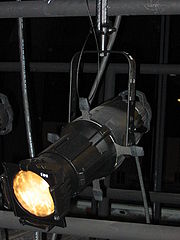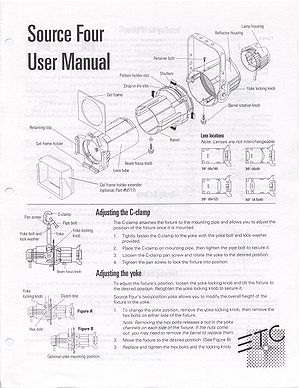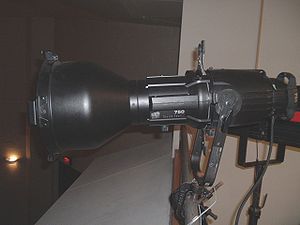
Source four
Encyclopedia

Electronic Theatre Controls
Electronic Theatre Controls is a privately held corporation with global headquarters in Middleton, Wisconsin, United States. An international manufacturer of entertainment and architectural lighting systems, ETC offers professional lighting fixtures, lighting control consoles, dimming equipment...
(ETC) Source Four (also known unofficially as Source 4 or S4) is an ellipsoidal reflector spotlight (ERS) used in stage lighting
Stage lighting
Modern stage lighting is a flexible tool in the production of theatre, dance, opera and other performance arts. Several different types of stage lighting instruments are used in the pursuit of the various principles or goals of lighting. Stage lighting has grown considerably in recent years...
. First released in 1992, the Source Four features an improved lamp and reflector compared to previous ERS designs, tool-free lamp adjustment, and a rotating, interchangeable shutter barrel. The Source Four is widely used by professional theaters in the United States.
Glass reflector
The Source Four is the first ERS to use a faceted borosilicateBorosilicate glass
Borosilicate glass is a type of glass with the main glass-forming constituents silica and boron oxide. Borosilicate glasses are known for having very low coefficients of thermal expansion , making them resistant to thermal shock, more so than any other common glass...
reflector behind the lamp
. Nearly all stage lights
Stage lighting instrument
Stage lighting instruments are used in stage lighting to illuminate theatrical productions, concerts, and other performances taking place in live performance venues. They are also used to light television studios and sound stages.Many stagecraft terms vary between the United States and the United...
have some form of reflector positioned behind the lamp to reflect otherwise wasted light out the front of the instrument. The Source Four's reflector is dichroic
Dichroic filter
A dichroic filter, thin-film filter, or interference filter is a very accurate color filter used to selectively pass light of a small range of colors while reflecting other colors. By comparison, dichroic mirrors and dichroic reflectors tend to be characterized by the color of light that they...
, meaning that it reflects light
Electromagnetic spectrum
The electromagnetic spectrum is the range of all possible frequencies of electromagnetic radiation. The "electromagnetic spectrum" of an object is the characteristic distribution of electromagnetic radiation emitted or absorbed by that particular object....
of only certain wavelengths. The Source Four's reflector reflects back 95% of the visible light striking it, while allowing over 90% of the infrared
Infrared
Infrared light is electromagnetic radiation with a wavelength longer than that of visible light, measured from the nominal edge of visible red light at 0.74 micrometres , and extending conventionally to 300 µm...
radiation (heat) to pass out the back of the instrument
. This produces a much cooler light which is less destructive to gobo
Gobo (lighting)
A gobo derived from "Go Between" or Goes Before Optics -originally used on film sets, is a physical template slotted inside, or placed in front of, a lighting source, used to control the shape of emitted light....
s or color gel
Color gel
A color gel or color filter , also known as lighting gel or simply gel, is a transparent colored material that is used in theatre, event production, photography, videography and cinematography to color light and for color correction...
s at the front of the fixture, as well as talent.

Lamp adjustment
Lamp adjustment, or bench focus, is used to achieve an even field of light, and to remove hot-spots which can destroy color filters. On the Source Four, adjustment can be done without tools, and is more accurate than previous instruments, compared to the four-screw assembly. With this assembly it is often difficult for lamps to maintain alignment. The most common problem is the lamp dropping too low in the reflector, causing a hot spot at the bottom of the beam, and a dark area at the top. This may be corrected by a realignment of the lamp.There are two adjustments that can be made to the cap.
1. The center screw controls the depth of the lamp into the reflector. Loosening this screw causes a spring to push the lamp further inside the reflector, creating a brighter hot spot in the beam. Tightening this screw will draw the lamp backwards, for a flatter field.
2. The wider wing nut that sits underneath the center screw controls the placement of the lamp within the reflector. Loosening this wing nut will free the lamp assembly from the cap housing. The user can then push the entire adjustment screw and lamp holder up, down, left or right to center the hot spot in the beam. It is this adjustment that most commonly needs to be made with lights that haven't been regularly serviced. Sometimes it is helpful to use a screwdriver or wrench or other thin tool to reach between the body of the light and the cap to push up on the lamp holder assembly and hold it in place while you tighten the wing nut back down.
HPL lamp
The proprietary HPL (High Performance Lamp) lamp uses a compact filament, which concentrates the most light where it is efficient in an ellipsoidal reflector. At 575 wattWatt
The watt is a derived unit of power in the International System of Units , named after the Scottish engineer James Watt . The unit, defined as one joule per second, measures the rate of energy conversion.-Definition:...
s, the HPL lamp in a Source Four produces light equivalent to a 1000 watt spotlight using previous technology. This lower amount of energy consumption saves electricity and creates less heat. The HPL lamp also gives the fixture its name. The lamp (light source) has 4 filament strands, hence Source Four. It is also available in 750W (both 120v & 77v), 375W and 550W(77v) versions. HPL lamps are also available in longer life versions that reduce the color temperature
Color temperature
Color temperature is a characteristic of visible light that has important applications in lighting, photography, videography, publishing, manufacturing, astrophysics, and other fields. The color temperature of a light source is the temperature of an ideal black-body radiator that radiates light of...
from 3250 kelvin to 3050 kelvin to give the lamp a life of around 1500–2000 hours as opposed to the 300-400 hour life of the standard HPL.
HID
ETC also manufactures an HID (high-intensity discharge) Source Four with a metal-halide lamp. The fixture has a ballast attached to the yoke of the fixture which provides the added power required to strike and operate an HID lamp. HID lamps are not dimmable. The HID fixture uses less energy than the standard HPL lamp.Barrel

Stainless steel
In metallurgy, stainless steel, also known as inox steel or inox from French "inoxydable", is defined as a steel alloy with a minimum of 10.5 or 11% chromium content by mass....
, which does not warp easily under the heat of the lamp. The shutters are arranged in 3 planes, allowing a degree of freedom in shutter placement by the extreme angles they can be racked to. The top and bottom shutters are on their own plane, with the 2 side shutters sharing a single plane. Occasionally with difficult shots and extreme shutter angles this sometimes causes the side shutters to hit each other, preventing a perfect focus. One option is to rotate the shutter assembly and try to achieve the same effect with different shutters. A more extreme work around is to remove the shutter assembly from the unit body and reattach it 90º offset, so that the bottom and top shutters effectively become the side shutters.
ETC also offers a variety of interchangeable lens tubes with various field angles. These are: 90, 70, 50, 36, 26, 19, 14, 10, and 5 degree lens tubes, some of which are available as enhanced definition lens tubes (EDLT). The Source Four is also available as a zoom fixture, with a non-interchangeable lens tube. According to ETC's manual, the lenses in each lens tube cannot be reoriented, added or removed. Lenses come from the factory with a painted-on dot denoting the front face. The inside of the lens tube shows which slot is for which lens.
Different field angles are needed for different venues with different catwalk
Catwalk (theater)
A catwalk is an elevated service platform from which many of the technical functions of a theater, such as lighting and sound, may be manipulated.- Function :...
and electric systems (and, therefore, different throws). A lens tube with a smaller field angle will light an area from far away, whereas a large beam degree such as a 90 degree can be much closer in order to light the same area. A 90 degree Source Four might be used to project a gobo from the rear only 5 feet away on a scrim at the back of the stage, while a 10 degree could be used in the back of the house, for example, in the technical booth
Control booth (theater)
The control booth, control room, lighting box, technical booth, or just booth to theatre or television technicians is the area designated for the operation of technical equipment , and is sometimes the location of the deputy stage manager's station as well as the lighting controls and sound board...
where a technician
Theatrical Technician
A theatrical technician, is a person who operates technical equipment and systems in the Performing arts and Entertainment industry...
could access it to refocus or change gobos
Gobo (lighting)
A gobo derived from "Go Between" or Goes Before Optics -originally used on film sets, is a physical template slotted inside, or placed in front of, a lighting source, used to control the shape of emitted light....
during a show. A zoom gives the option of adjusting the field angle within a specified range without changing the lens tube. This is needed in the case of lighting fixtures that need to be re-focused frequently to different areas of the performing area, without having to rehang them in a different position in the lighting rig. There are two Source Four Zoom fixtures, the 15-30 degree and the 25-50 degree.
Enhanced definition lens tube
In November 2005, ETC released the Enhanced Definition Lens Tube (EDLT). The EDLT is designed to produce images from gobosGobo (lighting)
A gobo derived from "Go Between" or Goes Before Optics -originally used on film sets, is a physical template slotted inside, or placed in front of, a lighting source, used to control the shape of emitted light....
and other focus-critical instrument accessories more clearly and accurately than with the standard lens barrels. The lenses in the tube are coated with an anti-reflective material and are machined to more exact standards than the standard Source Four lens. The EDLT also increases lumen output. It is available in 19, 26, 36 and 50 degree barrels.
Third party offerings
Although the Source Four is designed to accept the same accessories as other lighting instruments, many third party manufacturers have designed products specifically for the Source Four. City Theatrical manufactures a line of products that retrofit a Source Four into a tungsten source followspotFollowspot
A followspot, sometimes known as a spot light, is a powerful stage lighting instrument which projects a bright beam of light onto a performance space. Followspots are controlled by a spotlight operator who follows actors around the stage...
. Ocean Thin Films, a manufacturer of scientific optics and instruments, including the color wheels for the Vari-Lite color fixtures, manufactures the SeaChanger Color Engine
SeaChanger Color Engine
The SeaChanger Color Engine is an electro-mechanical device that is used to control light color in entertainment-industry lighting applications. The unit employs four overlapped color filter wheels, inserted into a light beam near its source, to produce colored light. This is in contrast to color...
that utilizes gradient dichroic disks to control color. The unit is mounted in between the lamp assembly and optics and is controlled via DMX512.
Great American Market (GAM) offers a special effects unit, the SX4 that is mounted inside a Source Four in a similar manner to the Seachanger Color Engine. and offers a large selection of drop-in accessories that range from gobo-changers to overlapping looping gobos. Several manufacturers of HMI sources, such as Kobold, provide lighting fixtures that provide "daylight balanced" light through the Source 4 without the use of gels
Color gel
A color gel or color filter , also known as lighting gel or simply gel, is a transparent colored material that is used in theatre, event production, photography, videography and cinematography to color light and for color correction...
. This is accomplished by replacing the lamp assembly on the back of the Source 4 with an HMI lamp head.
Other Source Four products
In 1995, ETC introduced the Source Four PARSource Four PAR
The Source Four PAR is a lighting fixture manufactured by Electronic Theatre Controls as a modern, energy efficient alternative to the traditional Parabolic aluminized reflector fixtures.-Construction:...
which is meant to replicate the performance of PAR cans while lessening the disadvantages involved with traditional PAR cans.
In 1999, ETC introduced the Source Four PARNel as an alternative to Fresnel lantern
Fresnel lantern
A Fresnel lantern is a common lantern used in theatre, which employs a Fresnel lens to wash light over an area of the stage. The lens produces a wider, soft-edged beam of light, which is commonly used for back light and top light....
s.
In 2002, ETC introduced the Source Four MultiPAR as an alternative to striplights.
In 2004, ETC introduced the Source Four Revolution, ETC's first moving fixture
Intelligent lighting
Intelligent lighting refers to stage lighting that has automated or mechanical abilities beyond those of traditional, stationary illumination. Although the most advanced intelligent lights can produce extraordinarily complex effects, the intelligence lies with the programmer of the show rather...
. The Revolution was awarded both the EDDY and ABTT awards. The Revolution has the same filament structure as famous HPL Source Four lamp, as opposed to most other moving lights, which use arc lamps. Also, the Revolution uses a gel string color scroller instead of the typical color wheel, thus allowing lighting designers to use familiar gel choices.

